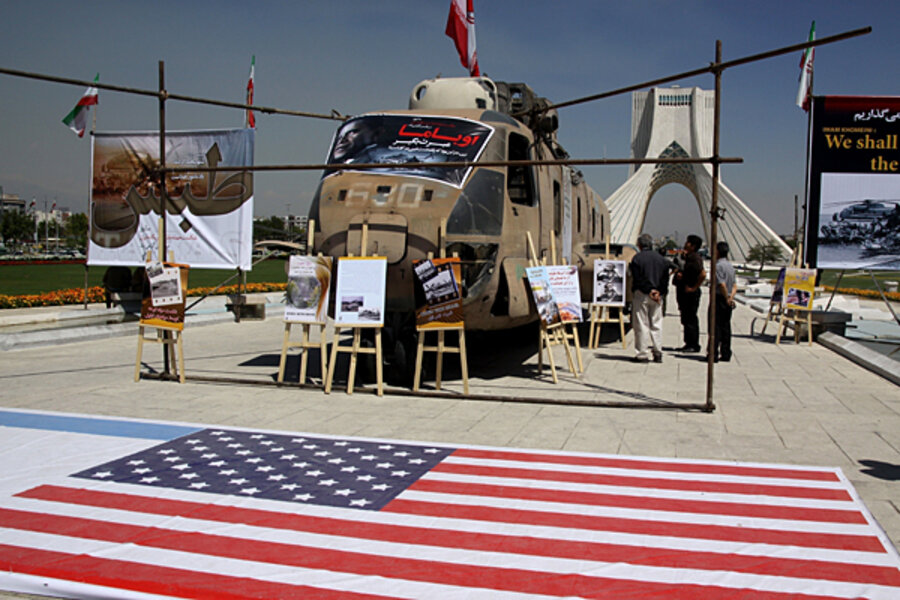In SEAL Team Six success, lessons from 'horrible night' in Iran 30 years ago
Loading...
| Washington
The Navy SEAL commando raid of Osama Bin Laden’s compound this week – ultimately resulting in his death – is being hailed as one of the most pivotal black operations achievements in the highly secretive existence of US Joint Special Operations Command.
SEAL Team Six – known among operators as the Naval Special Warfare Development Group, or DEVGRU – drilled for the bin Laden mission for months. In preparation for the close quarters battles that would come with storming the compound, team members fired upwards of 700 rounds of bullets a week in houses built specifically for learning how to dodge and avoid shooting ricocheted rounds, according to former operatives.
But the special mission units of Joint Special Operations Command (JSOC), which execute the most classified US military operations, have not always enjoyed such extensive coordinated training – or such success. In fact, JSOC – the Pentagon’s umbrella command for the Army's Delta Force and Navy SEALs – was founded on the heels of some very public failures.
The lessons learned from previous failures – particularly one “horrible night” in April 1980 – helped to make the strike on Mr. bin Laden’s compound “a great day” in special operations force history, says retired Delta Force operative Lt. Col. Lewis “Bucky” Burruss.
It was the aborted attempt to rescue the 52 hostages being held in Iran in 1980 that Burruss calls “the wakeup call in the desert” for the US military. “It brought everyone around to the need for better special-operations capability,” adds retired Rear Adm. George Worthington, the first deputy secretary of Defense for special operations and low-intensity conflict.
How special ops have changed
Known alternately as Operation Eagle Claw and Desert One, the mission was a heartbreaking and public debacle that failed to bring Americans being held captive home and resulted in the deaths of eight US service members.
Yet the failures ultimately resulted in the creation of a more highly coordinated and resourced Joint Special Operations Command.
It also shaped the formation of some of the Pentagon’s top officers, including former Army Chief of Staff Peter Schoomaker, who was part of the attempted Iranian hostage rescue as a Delta Force operator. “He was on the ground that night,” says Mr. Burruss. “He learned a whole lot and never forgot it.”
Current Air Force Chief of Staff Gen. Norton Schwartz was flying with special operators immediately following the hostage rescue attempt, and received some of the first training that was an effort to revamp the force.
Up until that point, special operators were not particularly well-funded or equipped. “We lacked reliable aircraft, we lacked reliable pilots, we lacked some of the weaponry,” he says. “It was pretty rudimentary – a lot of people don’t seem to understand what helicopters were like in those days – how much fuel they burned, how they wouldn’t restart if they were shut down.”
Operation Eagle Claw: What went wrong
In Operation Eagle Claw, for instance, special operations rescuers were “ready to go, but no one could get us there,” says Burruss, noting that the hostage crisis began in December – four months before the mission.
In the end, Eagle Claw went ahead with aviation assets borrowed from other units and pilots who had not trained extensively with the special-operations team.
Once the operation actually began, it unfolded as a series of mistakes and accidents.
First, the rescue mission was aborted when one of eight helicopters was grounded after running into a dust storm, another returned to the aircraft carrier, and a third was damaged. “Instead of picking up the crew and continuing on, the pilots turned around and went back,” Burruss says. “If the guys on the ground know each other closely and work together regularly – well, I can’t imagine. They would never turn around – they’d get there or die trying.”
Later, the operation turned tragic when, on the aborted mission, one of the helicopters carrying troops collided with a C-130, bursting into flames and killing eight US troops aboard.
The lessons learned
In the aftermath of the disastrous mission, the White House launched a commission, which ultimately resulted in a team of dedicated pilots strictly for special-operations units. The failures of Eagle Claw also led to the formation of JSOC, and gave it responsibility for making sure that special operators have the equipment and resources they need for missions.
The lessons learned on that night had clear echoes in the successes of the Sunday strike in Pakistan. Sources say there was only one hitch – a helicopter that experienced mechanical failure, was forced to land inside bin Laden’s compound, and was unable to take off again. Before they departed the compound, special operators detonated it to keep it from falling into enemy hands.
By contrast, helicopters abandoned in Eagle Claw were recovered and used by Iran.
A senior defense official says that there will be a review of the helicopter malfunction Sunday. “With these operations we do extensive hot washes afterward to look at every aspect of the operation,” the official said in a background briefing at the Pentagon. “We will certainly look at that. But as I emphasized earlier, the problem that was encountered did not impede the operation.”
And that, Burruss says, is precisely the point. “The greatest thing about this success in my mind is that it’s something these guys deserved,” he said. “Not just for the last few days, but for what they have been doing, often in silence, for years and years.”





